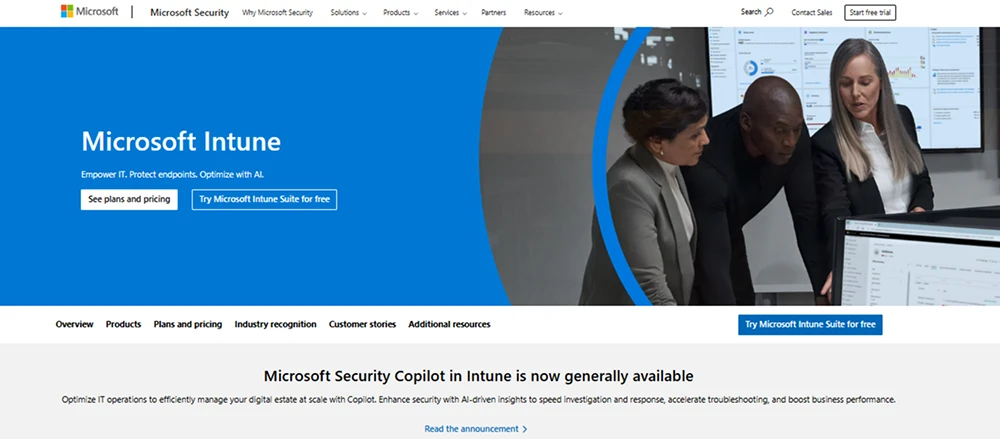Microsoft Intune (Endpoint Manager) Overview & 2025 Industry Position
Microsoft Intune (Endpoint Manager) has firmly established itself as one of the premier Unified Endpoint Management (UEM) solutions in the enterprise cybersecurity and IT automation landscape. Combining robust mobile device management (MDM), mobile application management (MAM), and endpoint security controls, the platform plays a critical role in securing enterprise data while offering flexibility for IT ops. In 2025, it holds an even more elevated position as the digital workforce becomes increasingly hybrid, and organizations seek centralized, policy-driven endpoint management aligned with zero trust security frameworks.
From Launch to 2025: Microsoft Intune (Endpoint Manager)’s Journey
Microsoft Intune was introduced in 2010 as a cloud-based MDM solution. It has gone through key evolutionary stages, including the 2017 alignment with Enterprise Mobility + Security (EMS), and its 2019 umbrella merge under Microsoft Endpoint Manager. In 2021, new endpoint analytics emerged, enhancing proactive policy enforcement. By 2023, Intune’s management scope expanded to Linux, and Windows Autopilot was further reinforced for zero-touch provisioning. In 2024, Microsoft rearchitected the interface for a more intuitive admin experience, paving the way for 2025’s key focus: leveraging AI-driven policy insights and tighter Defender integration to preempt threats in real time.

Microsoft Intune (Endpoint Manager) Key Features
The platform is a unified hub of endpoint security, compliance, and provisioning tools, featuring:
- Cross-platform endpoint management (Windows, macOS, Android, iOS, Linux).
- Conditional access with Azure AD policies.
- Mobile application management without device enrollment (MAM-WE).
- Windows Autopilot for zero-touch deployment.
- Defender for Endpoint integration for automated threat detection.
- Granular role-based access control (RBAC).
- Remote wipe, encryption enforcement, and compliance automation.
- Endpoint analytics and proactive remediation scripts.
Workflow & UX
The newest interface refinements in Intune elevate workflow accessibility for both IT admins and compliance officers. The UX is clean with customizable navigation, context-rich policy views, and intuitive wizard-based setups. Endpoint reporting and remediation alerts are prominently visible, and setup guides help streamline common workflows like app policy creation or deployment profiles. Microsoft’s Fluent UI principles ensure consistency across the admin center.
Pro Tip: Use role-based profiles to control interface access, ensuring that help desk and security teams only see relevant data.
Microsoft Intune (Endpoint Manager) Pricing Analysis & Value Metrics
As of July 2025, pricing for Microsoft Intune varies by licensing bundle. Key options include:
| Plan | Monthly Price (USD) | Includes |
|---|---|---|
| Microsoft Intune (Standalone) | $8.50/user | UEM, MDM, MAM, Endpoint Security |
| Microsoft 365 E3 | $36/user | Office Apps, Teams, Intune, Azure AD Basic |
| Microsoft 365 E5 | $57/user | All E3 features + Defender, Azure AD P2 |
Value Assessment: While standalone is cost-effective for endpoint-first users, Microsoft 365 E3 and E5 unlock broader security and collaboration value.
Competitive Landscape
| Provider | Unique Strength | Pricing Start | Ideal Buyer |
|---|---|---|---|
| Microsoft Intune | Integrated with Microsoft 365 | $8.50/user | Microsoft-centric enterprises |
| VMware Workspace ONE | Customization and VDI | $6/user | Hybrid cloud-first orgs |
| Jamf Pro | Best for Apple fleet management | $4/user | MacOS/iOS-focused teams |
| ManageEngine | Diversified device support | $5/device | SMBs, mixed OS shops |
Common Use Cases by Industry
- Healthcare: Enforce mobile access controls to patient data across BYOD.
- Finance: Align with compliance frameworks via conditional access and audit trails.
- Education: Simplify provisioning with device templates and secure remote wipe.
- Retail: Secure POS tablets and deploy kiosk-mode endpoints remotely.
- Professional Services: Maintain secure email/apps without full device control.
Microsoft Intune (Endpoint Manager) Integrations
Integration is where Intune shines. With native tie-ins across Microsoft 365 and Azure, it connects seamlessly to:
- Azure Active Directory
- Defender for Endpoint
- Microsoft Purview (compliance)
- Teams and SharePoint
- ServiceNow (ticketing automation)
- Jamf (Apple-specific management)
Pros & Cons
- Pros: Seamless Microsoft 365 integration, granular policy control, role-based access, robust endpoint analytics.
- Cons: Complex initial setup for non-Microsoft environments, higher cost at scale, some Linux support limitations.
Final Thoughts
Microsoft Intune (Endpoint Manager) is best suited for organizations invested in Microsoft 365 or committed to a zero trust security approach. Its 2025 stack brings advanced automation, streamlined compliance, and fleet-wide visibility, ideal for mid-to-large enterprises with hybrid workforces. While smaller orgs may find cost or configuration depth overwhelming at first, the security ROI and long-term scalability are unmatched.
Microsoft Intune (Endpoint Manager) Q & A
Microsoft Intune supports Windows, macOS, iOS, Android, and Linux devices.
Yes, Intune offers mobile application management (MAM) capabilities that allow access controls without full device enrollment.
Yes, Intune is included with Microsoft 365 E3 and E5 licenses, offering integrated endpoint management.
Yes. Using Windows Autopilot and Apple Business Manager, Intune enables zero-touch setup for new devices.
Devices out of compliance can be automatically quarantined, restricted from access, or wiped, depending on configured conditional access policies.